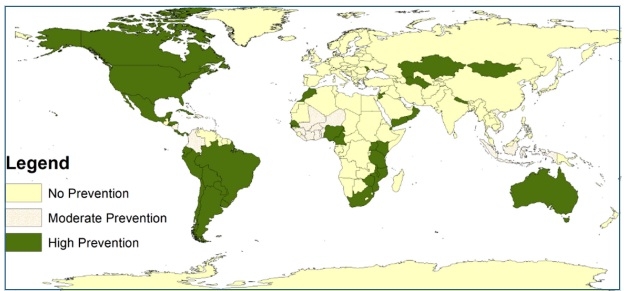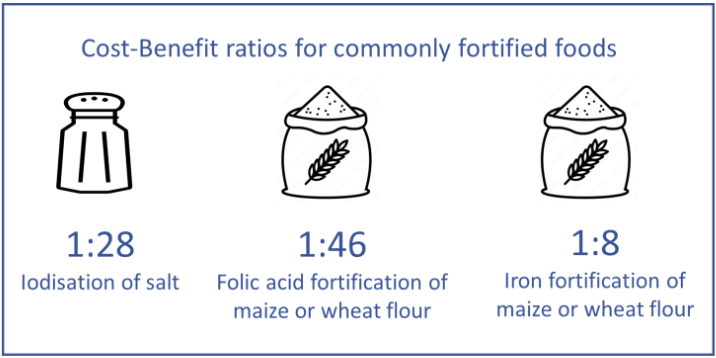
19 Nov Folate inadequacies and global fortification efforts
In recent years, studies assessing the intake and adequacy of vitamins and minerals have emphasized the growing prevalence of micronutrient deficiencies globally. Folate is one such nutrient of concern. Folate is a B-vitamin that is naturally present in some foods, especially dark green leafy vegetables, fruits, nuts, legumes, eggs, dairy products, meat, and poultry. A synthetic form of the nutrient, folic acid, is often added to breakfast cereals and grain flours. In this Thought for Food, we explore the extent of the problem of folate deficiency and the role of fortification in tackling this.
Folate deficiency as a global nutrition problem
Despite its importance in foetal development and growth, folate is one of the micronutrients found to have the highest estimated prevalence of inadequate intake globally. A recent study estimated that more than four billion people, representing 54% of the global population, have inadequate dietary intakes of folate. The form and source of folate is a major factor in achieving adequate intake. Dietary folate has poorer bioavailability than folic acid – only 50% compared to 85%. Naturally occurring folate in food is also unstable. It is estimated that up to 70% can be easily lost during food preparation and processing. Consequently, dietary intake alone may not be sufficient to provide the estimated daily requirements for folate.
Inadequate folate intake causes several disorders, posing major risks to health, especially for children, and significantly increases the risk of child mortality. Insufficient maternal blood folate concentration during conception and the earlier weeks of gestation has been identified as one of the major risk factors for birth defects affecting the neural tube. These include spina bifida and anencephaly, which cause substantial mortality, morbidity, disability, and psychological and economic costs. In a global estimation of the prevalence of Neural Tube Defects (NTDs) in 2018, it was found that one in every 500 births globally are affected by these NTDs annually. In low-income and middle-income countries, the prevalence exceeds one in every 100 births, reaching over 320,000 affected pregnancies worldwide. However, many of these occurrences of NTDs are preventable with folic acid interventions.
Folate fortification of food as a prevention strategy
Large-scale food fortification is a highly recommended and established food system intervention proven to eliminate vitamin and mineral deficiencies. Multiple studies from different countries support the effectiveness of food fortification with folic acid in safely preventing spina bifida and anencephaly. A systematic review found that food fortification with folic acid reduces the occurrence of NTDs by 41% annually. In some countries, folate fortification of food has reduced incidence of births affected with NTDs to around 5 in 10,000 births annually through helping women of reproductive age to achieve folate sufficiency. As well as the health outcomes, the strategy is useful for preventing cognitive impairment and reduced productivity resulting in loss of human capital.
Large-scale food fortification has a distinct combination of qualities including scalability, sustainability, and cost-effectiveness, which makes it a suitable approach for countries and populations at different economic and developmental levels.
Current gaps in folate fortification efforts
Despite the evidence supporting the effectiveness of food fortification in addressing folate and other micronutrient deficiencies at a lower cost of implementation, only 70 countries globally currently have mandatory folic acid fortification of wheat flour, maize flour, or rice. About 215,000 cases of NTDs could have been prevented in 2019 in countries that did not have folic acid fortification programs. Also, not all fortification programs meet the required standards, hence gaps in compliance, quality and coverage of fortified foods put further pregnancies at risk of NTDs. Figure 1 shows countries with mandatory folic acid fortification programs and the proportion providing >150 mcg/capita/day of folic acid for achieving effective prevention of folic acid preventable NTDs.

No prevention = countries consuming less than 20 mcg/day of folic acid from fortified flour; moderate prevention = countries consuming 100 mcg/day on average of folic acid from fortified flour; high prevention = countries consuming 200 mcg/day on average (≥151 mcg/day) of folic acid from fortified flour.
Cost-effectiveness and long-term benefits of folic acid fortification
Folic acid fortification is also favoured with a strong economic argument. A cost-benefit analysis found that every US$1 invested in folate fortification generates US$46 economic returns in benefits from prevented disease, improved earnings, and enhanced work productivity. This is a substantial benefit when compared to estimated returns from other critical public health interventions, such as vaccination, where the cost-benefit ratio is approximately 1:16. Figure 2 below shows cost-benefit ratio for iodine, folic acid, and iron fortification of food. Iodine fortification has been discussed in a previous article.

A retrospective assessment of cost savings from folate fortification compared with treating children with spina bifida reported significant cost savings as shown in Table 1.

Adapting fortification to diverse dietary patterns allows its benefits to reach a substantial proportion of the population, including low-income individuals living in areas of high urbanisation and other susceptible groups, improving health equity.
Countries continue to benefit from the health and economic gains following the initial set up and implementation of folic acid fortification programs. Also, other micronutrients such as iron, vitamin B12 and zinc could be added to existing folic acid fortification vehicles to address other nutritional deficiencies at a minimal cost increase.
In 2023, national delegates to the 76th World Health Assembly (WHA) resolved to accelerate efforts to prevent micronutrient deficiencies through food fortification. Implementing this resolution at country level and giving attention to provision of adequately fortified foods to align with dietary patterns and levels of micronutrient malnutrition in every country would go a long way to improving the nutritional status of the population. Countries can achieve this by strengthening financing and regulatory monitoring mechanisms for existing large scale food fortification (LSFF) programs and where necessary, improve programs through updating existing fortification standards. Strengthening regulations will also ensure a level playing field for fortified food producers where all are held to the same standard.
The cost of inaction towards folate fortification is profound, putting lives at risk and depleting human capital for future economic growth and development. Acting now on mandatory food fortification will help to alleviate the burden posed by micronutrient deficiencies to the health and economic growth of countries. This is particularly important for susceptible populations in low and middle-income countries who are at the greatest disadvantage when it comes to achieving adequate dietary intake of micronutrients, face food security challenges and are most susceptible to other infectious diseases.
This Thought of Food was written by our PhD student, Justine B. Coomson.





